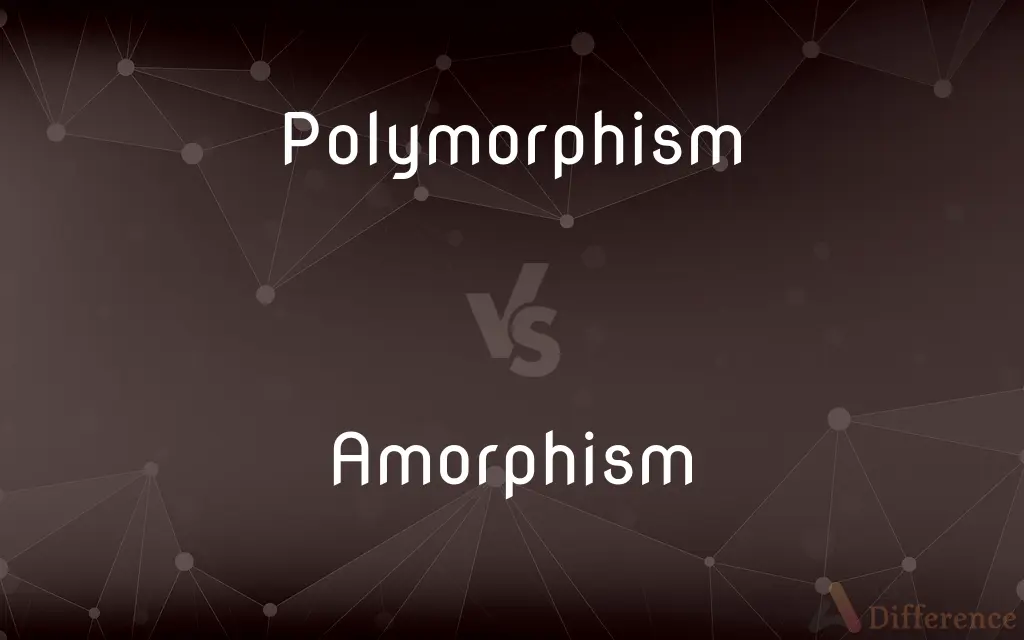Polymorphism vs. Amorphism — What's the Difference?
By Tayyaba Rehman — Published on January 11, 2024
Polymorphism refers to the ability of a substance to exist in multiple forms or structures, while amorphism describes a substance lacking a crystalline structure.

Difference Between Polymorphism and Amorphism
Table of Contents
ADVERTISEMENT
Key Differences
Polymorphism is a property of certain substances to exist in more than one form or crystal structure. This phenomenon is observed in various materials, including metals, minerals, and polymers. Amorphism, on the other hand, refers to the lack of a well-defined crystalline structure in a substance. Amorphous materials do not have a regular arrangement of atoms.
In polymorphism, the different forms are called polymorphs and they exhibit different physical properties despite having the same chemical composition. For example, carbon can exist as both diamond and graphite, which are polymorphs of each other. Amorphous substances, such as glass, lack the orderly atomic structure found in crystals and therefore display different physical properties, like more flexibility and different optical characteristics.
Polymorphism can occur due to changes in temperature, pressure, or the presence of impurities, leading to different crystal structures. This characteristic is critical in fields like pharmaceuticals, where different polymorphs of a drug can have varying levels of solubility and bioavailability. Amorphism typically occurs when a substance solidifies too quickly for a crystal lattice to form, as seen in rapidly cooled liquids like volcanic glass.
In the context of materials science, polymorphism allows for a diversity of applications based on the same material, offering versatility. Amorphous materials are valued for their distinct properties like increased solubility or different optical properties compared to their crystalline counterparts.
Polymorphism is also a concept in biology, referring to the occurrence of different forms or morphs among species members, contributing to genetic diversity. In contrast, amorphism in the biological context is not a standard term and does not have a direct correlation.
ADVERTISEMENT
Comparison Chart
Definition
Ability to exist in multiple structural forms
Lack of a crystalline structure
Nature
Multiple orderly atomic structures
No orderly atomic structure
Example
Carbon as diamond and graphite
Glass or plastic
Occurrence
Due to conditions like temperature and pressure
Often due to rapid solidification
Physical Properties
Varies among different forms
Generally uniform but differs from crystalline form
Compare with Definitions
Polymorphism
Multiple crystal structures
The polymorphism of silicon dioxide results in different types of quartz.
Amorphism
Lack of crystalline structure
Glass is a classic example of amorphism.
Polymorphism
Existence in different forms
Carbon's polymorphism is evident in diamond and graphite.
Amorphism
Random atomic arrangement
Amorphism in certain plastics makes them more flexible.
Polymorphism
Variability in physical properties
Polymorphism in pharmaceuticals affects drug solubility.
Amorphism
Absence of long-range order
The amorphism in some alloys prevents corrosion.
Polymorphism
Biological diversity
Genetic polymorphism contributes to the variation in human traits.
Amorphism
Non-crystalline solid form
Silica gel exhibits amorphism.
Polymorphism
(Biology) The occurrence of more than one form, as several alleles of a particular gene or winged and wingless forms of the same species.
Amorphism
Rapid solidification result
Volcanic glass demonstrates amorphism due to rapid cooling.
Polymorphism
(Chemistry) Crystallization of a compound in at least two distinct forms. Also called pleomorphism.
Amorphism
The state or quality of being amorphous.
Polymorphism
The ability to assume different forms or shapes.
Amorphism
An amorphous quality.
Polymorphism
(object-oriented programming) The feature pertaining to the dynamic treatment of data elements based on their type, allowing for an instance of a method to have several definitions. en
Amorphism
A state of being amorphous; esp. a state of being without crystallization even in the minutest particles, as in glass, opal, etc.
Polymorphism
The property of certain typed formal systems of allowing for the use of type variables and binders/quantifiers over those type variables; likewise, the property of certain expressions (within such typed formal systems) of making use of at least one such typed variable.
Polymorphism
(crystallography) The ability of a solid material to exist in more than one form or crystal structure; pleomorphism.
Polymorphism
(genetics) The regular existence of two or more different genotypes within a given species or population; also, variability of amino acid sequences within a gene's protein.
Polymorphism
Same as Pleomorphism.
Polymorphism
The capability of assuming different forms; the capability of widely varying in form.
Polymorphism
(chemistry) the existence of different kinds of crystal of the same chemical compound
Polymorphism
Different manifestations
Linguistic polymorphism refers to words having multiple meanings.
Common Curiosities
Are all glasses amorphous?
Most common glasses, like window glass, are amorphous.
Can polymorphism affect drug effectiveness?
Yes, different polymorphs can have different bioavailability.
Do polymorphs have the same chemical composition?
Yes, but their physical structure and properties can vary.
Are amorphous materials less durable?
Not necessarily; it depends on the material and application.
Can a substance switch between polymorphs?
Yes, under different conditions like temperature or pressure.
Does amorphism affect a material's melting point?
Yes, amorphous materials often have a lower melting point.
Are diamonds a result of carbon polymorphism?
Yes, diamonds are a polymorphic form of carbon.
Can polymorphism be reversed?
In some cases, yes, depending on the material and conditions.
Is amorphism always due to rapid cooling?
Often, but not exclusively. Some materials are inherently amorphous.
Is polymorphism common in minerals?
Yes, many minerals exhibit polymorphism.
Are amorphous substances always solid?
Primarily, though the definition focuses on their atomic arrangement.
Can polymorphism be artificially induced?
Yes, through processes like temperature or pressure changes.
Is genetic polymorphism important for evolution?
Yes, it contributes to genetic diversity and adaptability.
Do all amorphous materials lack crystallinity?
Yes, that's a defining feature of amorphism.
Is plastic an example of an amorphous material?
Many plastics are amorphous.
Share Your Discovery

Previous Comparison
Error in Java vs. Exception in Java
Next Comparison
TDMA vs. CDMAAuthor Spotlight
Written by
Tayyaba RehmanTayyaba Rehman is a distinguished writer, currently serving as a primary contributor to askdifference.com. As a researcher in semantics and etymology, Tayyaba's passion for the complexity of languages and their distinctions has found a perfect home on the platform. Tayyaba delves into the intricacies of language, distinguishing between commonly confused words and phrases, thereby providing clarity for readers worldwide.












































